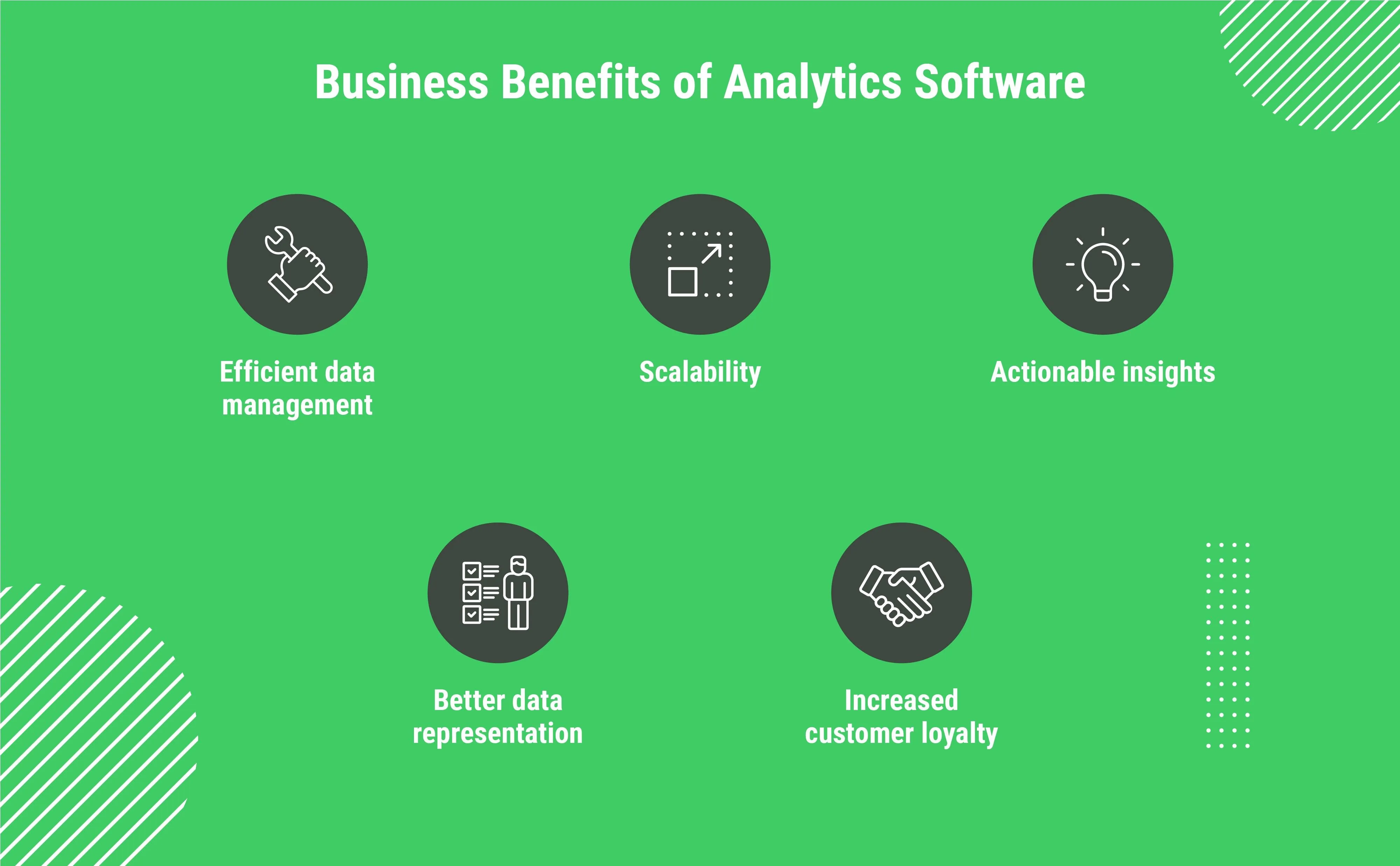How to Create Analytics Software for Retail to Win More Clients
Table of contents
When a retail business does not take into account changing customer preferences, it’s the beginning of its end. One of the examples is Kodak — a technology company that dominated the photographic film market during most of the 20th century and then blew its chance to lead the digital photography revolution.
In the modern world, where business decisions need to be both accurate and fast, retail businesses often take advantage of analytics software solutions. This post aims at showing you the ways in which they become game-changers, crucial features to look for, and the development process in some detail.
Retail Analytics Software Benefits
To begin with, let's figure out how analytics software can contribute to retailers' success.
First of all, it allows gathering data from multiple sources. Secondly, it covers the entire data lifecycle. Furthermore, an analytics platform leveraged to retail opens up space for data visualization that eases its comprehension and allows for better and smarter decision-making.
And here are the key advantages of using analytics software in retail.

Efficient data management
The efficiency of data management with analytics platforms is achieved through the platform's convenience. The system ensures easy access to data stored in different repositories of the company it is used in, allows for analysis of this data, and serves as a powerful business intelligence tool.
Scalability
Analytics platforms are created to handle large volumes of data, which means that even in case the volume increases, the solution will be capable of handling it without losses in performance.
Valuable insights
Having analytics software at hand means receiving valuable insights into customer behaviors, whether the talk is about how users scroll through the site, when and where they decide to make payments, where and when leaving the site, etc. Using these data, business owners can make smarter, data-driven decisions, create meaningful and successful marketing campaigns, as well as contribute to a better, more personalized, and engaging customer experience.
Customer loyalty
Because of the advantage above — the ability to receive valuable insights — it becomes possible for a business to get a deeper understanding of their audience’s minds and, as a result, better comprehend their customers' wants and needs.
Data representation
Analytics platform with a variety of tools and ways for data representation allows extracting meaning from data that comes from various sources. This could be achieved through multi-faceted dashboards, templates, interactive charts, drag-and-drop interfaces, etc.
All of the benefits listed below show that analytics platforms in retail can serve as a booster of the company's operations, as well as the source of meaningful insights into both internal and external processes. Still, not all retail analytics platforms are created equal, so let's take a look at the required feature set to continue the overview.
Must-Have Features of Retail Analytics Platforms
It is worthy of noting that the list of features we provide below can be extended. Still, our experience in building analytics platforms for retailers shows that these are the key ones.

Reporting
This is probably one of the most important features to include in an analytics platform as it allows users to organize their data in the most efficient way and form that can be easily comprehended. In this way, reporting becomes a feature that ensures transparent performance monitoring for business owners and managers.
The tip here is to ensure during the platform's development that reporting tools such as tables, charts, barcodes, infographics, etc. are included.
Data visualization
We've already discussed the benefit of data representation, and it derives exactly from the data visualization feature — the essence of any retail analytics platform.
Data visualization tools to consider for your platform are interactive dashboards, pattern indicators, diagrams, and others.
Data filtering and sorting
One more essential tool for efficient data management is filtering and sorting. Consider including both options to ensure that users of your platform will be able to customize their search and then arrange the results in a meaningful order.
Data transformation
Data transformation tools are essential for any system that offers data analysis as they allow extraction and preparation of data for the delivery of meaningful insights.
Integrations
The more sources of information you use for the extraction of data, the more accurate and valuable the outcomes are. So, when building an analytics platform, make sure to establish all the important integrations.
Information sharing
One of the must-haves for efficient collaborative data management is information sharing. In the system, it can be presented in various forms: pinning, commenting, report sharing, annotations adding, etc.
Web and mobile accessibility
As the world goes mobile, adding a mobile accessibility feature is no longer an option but a necessity. In this way, you will ensure added convenience of using the system and better business outcomes. While mobile app development is always a preferable option, you can at least make your web app mobile-friendly.
Now, let’s look at the necessary steps to build an analytics tool from scratch.
Steps to Create a Retail Analytics Platform
Analytics software for retail is a complex solution that requires a tough approach to its development. And while there are numerous delicate processes that make up the entire development phase, here are the key four stages for you to consider.
Step #1: Business analysis
Being an integral part of both web and mobile solutions development, business analysis (BA) generally falls into four stages.

Based on the analysis of the potential users' needs, this stage allows you to identify the list of must-have features for the future platform. What's more, the work of experts in IT consulting involved in this phase ensures that you will create a complete picture of software characteristics.
Step #2: Design
While the design stage is important to any project, in analytics software development it's of the highest value. Because the key idea of the solution under development is to produce easily comprehensible data, both UX and UI should be well-thought-out. And some tips can help:
- First of all, it's important to pay attention to information architecture to ensure that the solution is easy to use in terms of UX.
- Secondly, it's better to adhere to the minimalistic approach in the creation of UI in order not to overwhelm it with unneeded details that will drive users' attention out of important things.
Step #3: Development
When it comes to choosing the development approach, it will depend on such factors as wanted functionality, project budget, goals, etc. Generally, companies choose between these two options:
- Custom development from scratch
- Using an already existing software
Note that if you need a complex system that would be able to adjust any changes your business is facing, it will be easier to focus on custom development from scratch. Still, there are also solutions offered by leading software providers such as SAP.
Step #4: QA and testing
It does not matter if you choose a custom solution or implement a ready-made system into your business processes: to achieve better product quality, reduce bugs and errors, and determine the platform’s weaknesses — don’t miss the QA and testing phase. To reduce the number of operations and save your time and money, we recommend starting this phase at the same time as the development one.
Our Experience in the Development of Analytics Software for Retail
To provide you with a clearer picture of how your business can benefit from the analytics software, take a look at one of Emerline’s projects for a company working with distributors of drinks and beverages. The thing to mention here is that the delivered solution has already gained the status of the industry-leading application.
So, how was it? Our team was tasked to create a platform and mobile application that would facilitate work of distributors by allowing them to upload pictures directly into the system, so it would be easier to recognize where certain products are displayed, and in what quantities. Also, the customer wanted to extend the product’s capabilities with various analytics tools. And we met all the requirements.
Sales analytics platform delivered to the client allows:
- Centralized sales data management
- Mobile accessibility
- Real-time updates and monitoring
- Online data sharing
- Intuitive UI and interactive dashboards
- Data visualization
- Pipeline management
- Tracker execution
- Historical execution analytics
- Advanced exporting
- Identification of mutually supporting brands, etc.
All these features allow reducing supplier data analysis time from several hours to just 22 seconds.
So, as a result of complex development, the client received a solution that has everything needed for efficient, convenient, and well-organized performance. Furthermore, to meet the growing needs of the industry, the platform constantly develops and gets enriched with new innovative features. And if you are interested in receiving some similar solution, discussing your existing idea, or inventing it together with us, feel free to contact our specialists at any time, with any questions.
Published on Sep 1, 2021





